2017上半年初中英语教师资格考试真题试题(完美)
- 格式:docx
- 大小:36.07 KB
- 文档页数:15
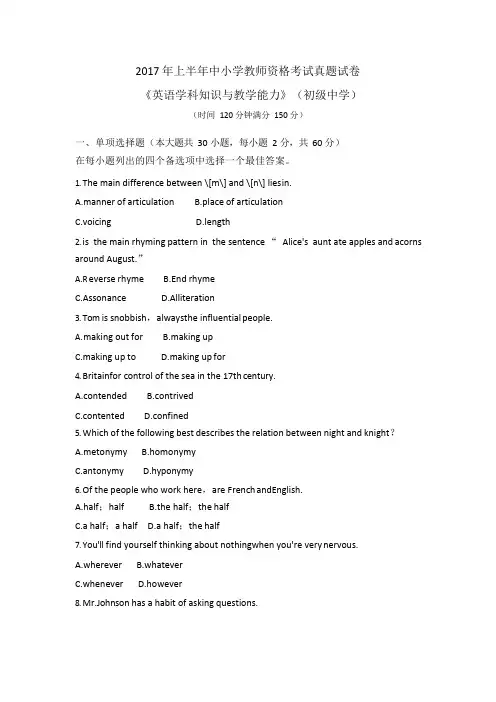
2017 年上半年中小学教师资格考试真题试卷《英语学科知识与教学能力》(初级中学)(时间120 分钟满分150 分)一、单项选择题(本大题共30 小题,每小题2 分,共60 分)在每小题列出的四个备选项中选择一个最佳答案。
1.The main difference between \[m\] and \[n\] lies i n.A.manner of articulationB.place of articulationC.voicingD.length2.is the main rhyming pattern in the sentence “ Alice's aunt ate apples and acorns around August.”A.R everse rhymeB.End rhymeC.AssonanceD.Alliteration3.Tom is snobbish,alwaysthe influential people.A.m aking out forB.making upC.making up toD.making up for4.Britainfor control of the sea in the 17th century.A.contendedB.contrivedC.contentedD.confined5.Which of the following best describes the relation between night and knight?A.metonymyB.homonymyC.antonymyD.hyponymy6.Of the people who work here,are French andEnglish.A.half;halfB.the half;the halfC.a half;a halfD.a half;the half7.You'll find yourself thinking about nothingwhen you're very n ervous.A.whereverB.whateverC.wheneverD.however8.Mr.Johnson has a habit of asking questions.A.a nd then not listen to the answersB.but then not listen to the answersC.and then not listening to the answersD.and then doesn't listen to the a nswers9.On hearing the utterance“It's hot here”,the listener opened the door.It is a(n).A.l ocutionary actB.illocutionary actC.direct speech actD.perlocutionary act10.What rhetoric device is used in the sentence“Many hands make light work”?A.S ynecdoche.B.Simile.C.Metaphor.D.Oxymoron.11.When the teacher attempts to elicit more information from the students by saying “And…”,“Good,anything else?”,etc.,he/she is playing the role of a.A.prompterB.participantC.managerD.consultant12.For more advanced learners,group work may be more appropriate than pair work for tasks that are.A.linguistically simpleB.structurally controlledC.cognitively challengingD.thematically non demanding13.When you focus on “utterance function ”and “expected response ”b y using examples like“Here you are”,“Thanks”,you are probably teaching language at the.A.lexical levelB.sentence levelC.grammatical levelD.discourse level14.Which of the following tasks fails to encourage active language use?A.Reciting a text.B.Bargaining in a shop.C.Writing an application letter.D.Reading to get a message.15.A teacher may encourage students towhen they come across new words in fast reading.A.take notesB.ask for helpC.guess meaning from contextD.look up the words in a dictionary16.Which of the following statements about task design is incorrect?A.Activities must have clear and attainable o bjectives.B.Activities should be confined to the classroom context.C.Activities must be relevant to students' life experiences.D.Activities should help develop students' language ability.17.When someone says “I know the word ”,he should not only understand its meaning but also be able to pronounce,spell andit.A.explainB.recognizeC.memorizee18.Teachers could encourage students to useto gather and organize their ideas for writing.A.elicitingB.mind mappingC.explainingD.brainstorming19.When students are asked to go to the local museum ,libraries ,etc.to find out information about endangered animals and work out a plan for an exhibition,they are doing a(n).A.surveyB.experimentC.projectD.presentation20.Which of the following tasks fails to develop students' skill of recognizing discourse patterns?A.Analyzing the structure of difficult sentences.B.Checking the logic of the author's arguments.C.Getting the scrambled sentences into a paragraph.D.Marking out common openers to stories and jokes.题答要不内线订装线订装线订装题答要不内线订装请阅读Passage 1,完成21~25 小题。
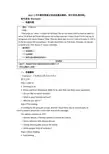
2017上半年教师资格证面试真题及解析:初中英语(第四批)初中英语《Cartoon》一、考题回顾二、考题解析《Cartoon》主要教学过程及板书设计教学过程Step 1 Lead-in1. Greeting to Ss.2. Show a cartoon Steamboat Willie to Ss, and then ask them some questions:----Do you like to watch cartoon?----What is your favorite cartoon?----Why do you like it?Step 2 Pre-readingAccording to the pictures on ppt. and the movie they saw in Lead-in part, Ss need to predict which one is the main idea of this passage.The options present on PPT:----Mickey Mouse, a famous symbol in American culture.----Some cartoons with Mickey Mouse.----Disney theme parks around the world.----What people think of cartoons?Step 3 While-reading1. Fast readingAsk students to read the passage quickly and then check their prediction answers.2. Careful readingHave Ss to read this passage carefully and talk about the main character in the cartoon. And then work with their partners to discuss the following chart:Then talk about their favorite Disney characters. T writes down their answers on the blackboard and ask Ss vote for their favorite Disney characters and write the number of vote on the board.Disney characters: Mickey Mouse, Minnie Mouse, Donald Duck, Mulan, Goofy, Snow White…Then four students a group to discuss why people love this Disney characters.Step 4 Post-readingFour students in a group, find another cartoon character just as famous as Mickey, and then to discuss why is the character popular.Step 5 Summary and Homework1. Summary: ask students to review what they’ve learnt today, and then T makes a conclusion.2. Homework: Does a role playDivide the class into several groups; each group has 5-6 students. They need to choose their favorite carton and each group member act as a role of the cartoon.板书设计答辩题目解析1.简述下,阅读教学中每次阅读的作用/目的分别是什么?【参考答案】首先,在快速阅读环节中,让学生第一遍快速阅读全文,判断自己在pre-reading部分所做的推测是否正确。
![[职业资格类试卷]2017年上半年中学教师资格认定考试(高级英语学科知识与教学能力)真题试卷.doc](https://uimg.taocdn.com/8108bc37f78a6529657d5335.webp)
[职业资格类试卷]2017年上半年中学教师资格认定考试(高级英语学科知识与教学能力)真题试卷一、单项选择题1 Which of the following is the feature shared by the English phonemes /m/ and /p/? (A)Voiced.(B)Voiceless.(C)Bilabial.(D)Dental.2 Which of the following is true of English sound system?(A)Aspiration is a distinctive feature.(B)Voicing is a distinctive phonetic feature.(C)Nasalization of vowels gives rise to another vowel.(D)Length of vowels differentiates one vowel from the other.3 Though the government encourages foreign investment,______ investors are reluctant to commit funds in the current climate situation in the country.(A)potential(B)affluent(C)optimistic(D)solid4 The man______the dark glasses fled away from the spot very rapidly. (A)in(B)at(C)of(D)by5 The morpheme "-ceive" in the word "conceive" is a______.(A)stem(B)root(C)allomorph(D)suffix6 There is no need______to teach children how to behave.(A)however(B)whatsoever(C)forever(D)whenever7 _____advance seems to be following advance on almost a monthly basis.(A)So rapid is the rate of progress that(B)Rapid as the rate of progress is that(C)So rapid is the rate of progress as(D)Rapid as the rate of progress as8 Tom, see that your sister gets safely back,______?(A)can you(B)won't we(C)won' t you(D)should we9 What rhetoric device is used in the sentence "This is a successful failure"?(A)Simile(B)Metonymy(C)Metaphor(D)Oxymoron10 The expression "As far as I know ..." suggests that people usually observe the Maxim of______in their daily conversations.(A)Quantity(B)Quality(C)Relevance(D)Manner11 When the teacher attempts to elicit more information from the students by saying "And...?", "Good. Anything else!", etc, he/she is playing the role of a______.(A)prompter(B)participant(C)manager(D)consultant12 For more advanced learners, group work may be more appropriate than pair work for tasks that are______.(A)linguistically simple(B)structurally controlled(C)cognitively challenging(D)thematically non-demanding13 When you focus on "utterance function" and "expected response" by using examples like "Here you are", "Thanks", you are probably teaching language at the______.(A)lexical level(B)sentence level(C)grammatical level(D)discourse level14 Which of the following tasks fails to encourage active language use?(A)Reciting a text.(B)Bargaining in a shop.(C)Writing an application letter.(D)Reading to get a message.15 A teacher may encourage students to______when they come across new words in fast reading.(A)take notes(B)ask for help(C)guess meaning from context(D)look up the words in a dictionary16 Which of the following statements about task design is incorrect?(A)Activities must have clear and attainable objectives.(B)Activities should be confined to the classroom context.(C)Activities must be relevant to students' life experiences.(D)Activities should help develop students' language ability.17 If someone says "I know the word", he should not only understand its meaning but also be able to pronounce, spell, and______it.(A)explain(B)recognize(C)memorize(D)use18 Teachers could encourage students to use______ to gather and organize their ideas for writing.(A)eliciting(B)mind mapping(C)explaining(D)brainstorming19 When students are asked to go to the local museum, libraries, etc. to find out information about endangered animals and work out a plan for an exhibition, they are doing a(n)______.(A)survey(B)experiment(C)project(D)presentation20 Which of the following tasks fails to develop students' skill of recognizing discourse patterns?(A)Analyzing the structure of difficult sentences.(B)Checking the logic of the author' s arguments.(C)Getting the scrambled sentences into a paragraph.(D)Marking out common openers to stories and jokes.二、简答题21 课堂互动(classroom interaction)是重要的教学活动形式。
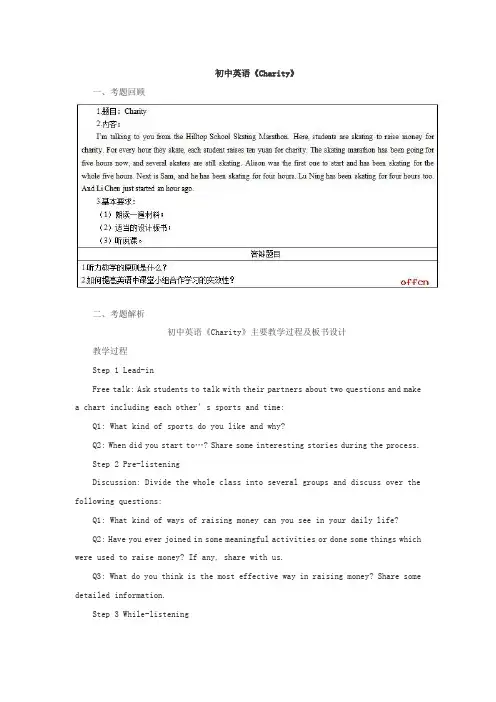
初中英语《Charity》一、考题回顾二、考题解析初中英语《Charity》主要教学过程及板书设计教学过程Step 1 Lead-inFree talk: Ask students to talk with their partners about two questions and make a chart including each other’s sports and time:Q1: What kind of sports do you like and why?Q2: When did you start to…?Share some interesting stories during the process.Step 2 Pre-listeningDiscussion: Divide the whole class into several groups and discuss over the following questions:Q1: What kind of ways of raising money can you see in your daily life?Q2: Have you ever joined in some meaningful activities or done some things which were used to raise money? If any, share with us.Q3: What do you think is the most effective way in raising money? Share some detailed information.Step 3 While-listening1. Ask students to listen to the passage for the first time and think about two questions:Q1: What kind of article it is?Q2: What does it mainly talk about?2. Ask students to listen for the second time carefully and answer the following questions:Q1: Why are students skating?Q2: How much money can they raise for one hour’s skating?Q3: How long have been Sam and Lu Ning skating?Q4: How much money together has been raised by skaters mentioned in the passage?3. Ask students to listen for the third time and see whether they have got the right answers or not. Pay attention to the intonation and rhythm of the news reporter and try to read with the tape.Step 4 Post-listeningTask 1: Ask students to underline some new words and all the structures of the present perfect progressive tense and try to guess the meaning of the new words and figure out the rules of the present perfect progressive tense. Give them some help if necessary, for example, give out some examples. At last, summarize the rules of the present perfect progressive tense together.Task 2: Do a competition: Show students some video clips about sports matches and ask them to act as news reporters to report the news. During report, try to use the present perfect progressive tense to express. Compete with the whole class and select the best reporter. The best one can be given some rewards.Step 5 Summary and homeworkSummary: Ask students to make a summary about what we have learned together to end up the class.Homework:1. Use the information in the chart which is asked to make at the beginning of the class to make sentences with the present perfect progressive tense.2. Think about what we can do in our daily life to make contribution to our charity and share with the class next time.板书设计答辩题目解析1.听力教学的原则是什么?【参考答案】a.听力教学要与其他方面技能相结合。
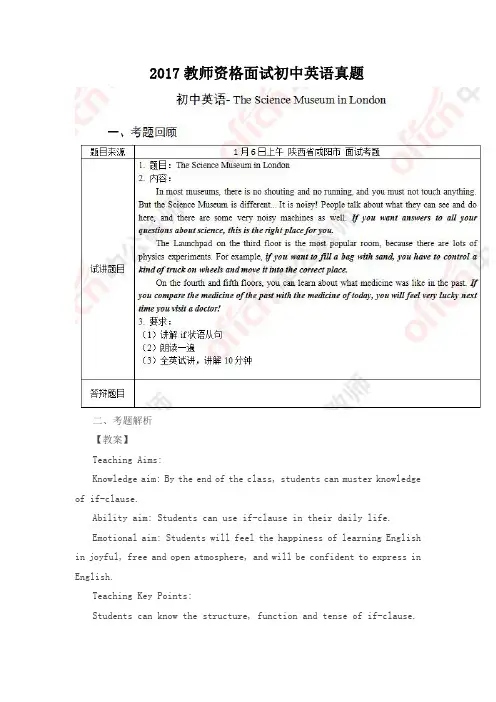
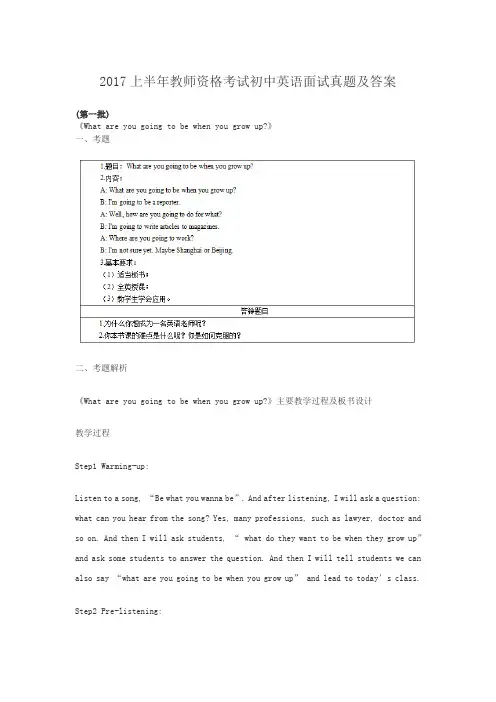
2017上半年教师资格考试初中英语面试真题及答案(第一批)《What are you going to be when you grow up?》一、考题二、考题解析《What are you going to be when you grow up?》主要教学过程及板书设计教学过程Step1 Warming-up:Listen to a song, “Be what you wanna be”. And after listening, I will ask a question: what can you hear from the song? Yes, many professions, such as lawyer, doctor and so on. And then I will ask students, “ what do they want to be when they grow up”and ask some students to answer the question. And then I will tell students we can also say “what are you going to be when you grow up” and lead to today’s class.Step2 Pre-listening:I will show some pictures on the PPT, the first picture is about reporter and the second picture is about the article. I will write down the two words on the blackboard and then I will ask the students to read after me.Step3 While-listening:I will ask students to listen to the radio for the first time and then match the sentence with the picture on the PPT. The first picture is about the reporter, the second picture is about writing magazines and the third picture is about Shanghai.Then I will ask students to listen to the radio for the second time and after listening, I will ask them to answer three questions on the blackboard, the first one is “What is he going to do when he grows up”, the second one is “how is he going to do for that” and the third one is “where is he going to work”.I will ask students to listen to the radio for the third time and they need to read after the radio. And then I will divide the students into two groups, group A acts as A, and group B acts as B, and read the passage.Step 4 Post-listeningWe will play a game called “hot potato”. When the music begins to play, students need to pass the flower. And when the music stops, the student who is holding the flower need to answer the question about “what is he going to do when he grows up, how is he going to do for that or where is he going to work”.And then we will have a group work, four students as a group and students need to make a survey about what is their group members going to be, how is he or she going to do for that and where is he going to work. Five minutes later, I will ask some groups to show their report.Step5 Summary and homeworkI will ask students to read the passage to summarize what we have learned today. After class, they need to search more information about the job they want to do.板书设计答辩题目解析1.为什么你想成为一名英语老师呢?【参考答案】因为我的妈妈是一名老师,她为学生奉献的精神深深感动了我。
![[职业资格类试卷]2017年上半年中学教师资格认定考试(初级英语学科知识与教学能力)真题试卷.doc](https://uimg.taocdn.com/96e2374367ec102de3bd8931.webp)
[职业资格类试卷]2017年上半年中学教师资格认定考试(初级英语学科知识与教学能力)真题试卷一、单项选择题1 The main difference between /m/ and /n/ lies in______.(A)manner of articulation(B)place of articulation(C)voicing(D)length2 _____ is the main rhyming pattern in the sentence "Alice's aunt ate apples and acorns around A ugust."(A)Reverse rhyme(B)End rhyme(C)Assonance(D)Alliteration3 Tom is snobbish, always______the influential people.(A)making out for(B)making up(C)making up to(D)making up for4 Britain______for control of the sea in the 17th century.(A)contended(B)contrived(C)contented(D)confined5 Which of the following best describes the relation between night and knight? (A)metonymy(B)homonymy(C)antonymy(D)hyponymy6 Of the people who work here,______are French and______ English.(A)half... half(B)the half... the half(C)a half... a half(D)a half... the half7 You'll find yourself thinking about nothing______when you' re very nervous. (A)wherever(B)whatsoever(C)whenever(D)however8 Mr. Johnson has a habit of asking questions______.(A)and then not listen to the answers(B)but then not listen for the answers(C)and then not listening to the answers(D)and then doesn' t listen to the answers9 On hearing the utterance "It's hot here ", the listener opened the door. It is a(n)______. (A)locutionary act(B)illocutionary act(C)direct speech act(D)perlocutionary act10 What rhetoric device is used in the sentence "Many hands make light work"?(A)Synecdoche.(B)Simile.(C)Metaphor.(D)Oxymoron.11 When the teacher attempts to elicit more information from the students by saying "And ...?",Good. Anything else?, etc, he/she is playing the role of a______.(A)prompter(B)participant(C)manager(D)consultant12 For more advanced learners, group work may be more appropriate than pair work for tasks that are______.(A)linguistically simple(B)structurally controlled(C)cognitively challenging(D)thematically non-demanding13 When you focus on "utterance function" and "expected response" by using examples like "Here you are", "Thanks", you are probably teaching language at the______.(A)lexical level(B)sentence level(C)grammatical level(D)discourse level14 Which of the following tasks fails to encourage active language use?(A)Reciting a text.(B)Bargaining in a shop.(C)Writing an application letter.(D)Reading to get a message.15 A teacher may encourage students to______when they come across new words in fast reading.(A)take notes(B)ask for help(C)guess meaning from context(D)look up the words in a dictionary16 Which of the following statements about task design is incorrect?(A)Activities must have clear and attainable objectives.(B)Activities should be confined to the classroom context.(C)Activities must be relevant to students' life experiences.(D)Activities should help develop students' language ability.17 If someone says "I know the word", he should not only understand its meaning but also be able to pronounce, spell, and______it.(A)explain(B)recognize(C)memorize(D)use18 Teachers could encourage students to use______to gather and organize their ideas for writing.(A)eliciting(B)mind mapping(C)explaining(D)brainstorming19 When students are asked to go to the local museum, libraries, etc. to find out information about endangered animals and work out a plan for an exhibition, they are doing a(n)______.(A)survey(B)experiment(C)project(D)presentation20 Which of the following tasks fails to develop students' skill of recognizing discourse patterns?(A)Analyzing the structure of difficult sentences.(B)Checking the logic of the author' s arguments.(C)Getting the scrambled sentences into a paragraph.(D)Marking out common openers to stories and jokes.二、简答题21 课后作业布置体现“差异性原则”。
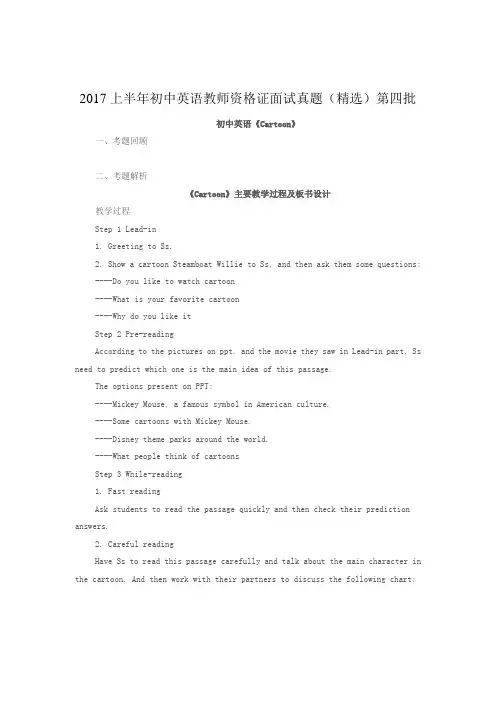
2017上半年初中英语教师资格证面试真题(精选)第四批初中英语《Cartoon》一、考题回顾二、考题解析《Cartoon》主要教学过程及板书设计教学过程Step 1 Lead-in1. Greeting to Ss.2. Show a cartoon Steamboat Willie to Ss, and then ask them some questions:----Do you like to watch cartoon----What is your favorite cartoon----Why do you like itStep 2 Pre-readingAccording to the pictures on ppt. and the movie they saw in Lead-in part, Ss need to predict which one is the main idea of this passage.The options present on PPT:----Mickey Mouse, a famous symbol in American culture.----Some cartoons with Mickey Mouse.----Disney theme parks around the world.----What people think of cartoonsStep 3 While-reading1. Fast readingAsk students to read the passage quickly and then check their prediction answers.2. Careful readingHave Ss to read this passage carefully and talk about the main character in the cartoon. And then work with their partners to discuss the following chart:Then talk about their favorite Disney characters. T writes down their answers on the blackboard and ask Ss vote for their favorite Disney characters and write the number of vote on the board.Disney characters: Mickey Mouse, Minnie Mouse, Donald Duck, Mulan, Goofy, Snow White…Then four students a group to discuss why people love this Disney characters.Step 4 Post-readingFour students in a group, find another cartoon character just as famous as Mickey, and then to discuss why is the character popular.Step 5 Summary and Homework1. Summary: ask students to review what they’ve learnt today, and then T makesa conclusion.2. Homework: Does a role playDivide the class into several groups; each group has 5-6 students. They need to choose their favorite carton and each group member act as a role of the cartoon.板书设计答辩题目解析1.简述下,阅读教学中每次阅读的作用/目的分别是什么【参考答案】首先,在快速阅读环节中,让学生第一遍快速阅读全文,判断自己在pre-reading部分所做的推测是否正确。
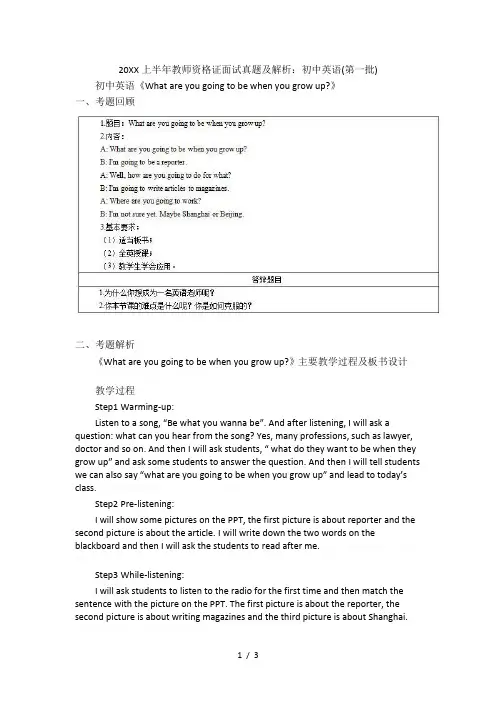
20XX上半年教师资格证面试真题及解析:初中英语(第一批) 初中英语《What are you going to be when you grow up?》一、考题回顾二、考题解析《What are you going to be when you grow up?》主要教学过程及板书设计教学过程Step1 Warming-up:Listen to a song, “Be what you wanna be”. And a fter listening, I will ask a question: what can you hear from the song? Yes, many professions, such as lawyer, doctor and so on. And then I will ask students, “ what do they want to be when they grow up” and ask some students to answer the question. And th en I will tell students we can also say “what are you going to be when you grow up” and lead to today’s class.Step2 Pre-listening:I will show some pictures on the PPT, the first picture is about reporter and the second picture is about the article. I will write down the two words on the blackboard and then I will ask the students to read after me.Step3 While-listening:I will ask students to listen to the radio for the first time and then match the sentence with the picture on the PPT. The first picture is about the reporter, the second picture is about writing magazines and the third picture is about Shanghai.Then I will ask students to listen to the radio for the second time and after listening, I will ask them to answer three questions on the blackboard, the first one is “What is he going to do when he grows up”, the second one is “how is he going to do for that” and the third one is “where is he going to work”.I will ask students to listen to the radio for the third time and they need to read after the radio. And then I will divide the students into two groups, group A acts as A, and group B acts as B, and read the passage.Step 4 Post-listeningWe will play a game called “hot potato”. When the music begins to play, students need to pass the flower. And when the music stops, the student who is holding the flower need to answer the question about “what is he going to do when he grows up, how is he going to do for that or where is he going to work”.And then we will have a group work, four students as a group and students need to make a survey about what is their group members going to be, how is he or she going to do for that and where is he going to work. Five minutes later, I will ask some groups to show their report.Step5 Summary and homeworkI will ask students to read the passage to summarize what we have learned today. After class, they need to search more information about the job they want to do.板书设计答辩题目解析1.为什么你想成为一名英语老师呢?【参考答案】因为我的妈妈是一名老师,她为学生奉献的精神深深感动了我。
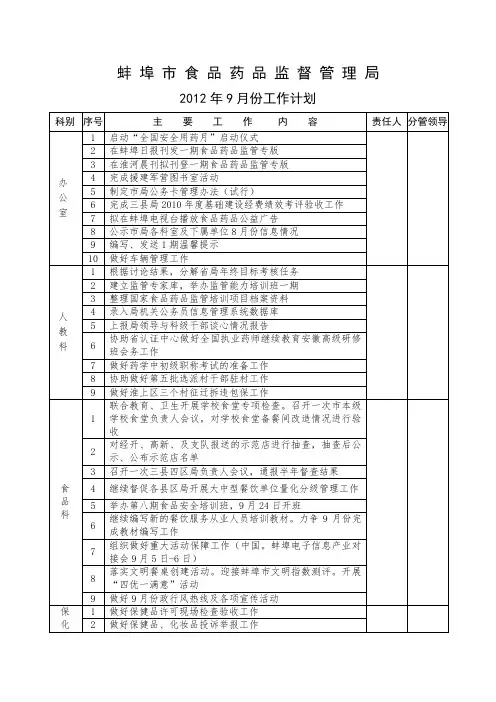
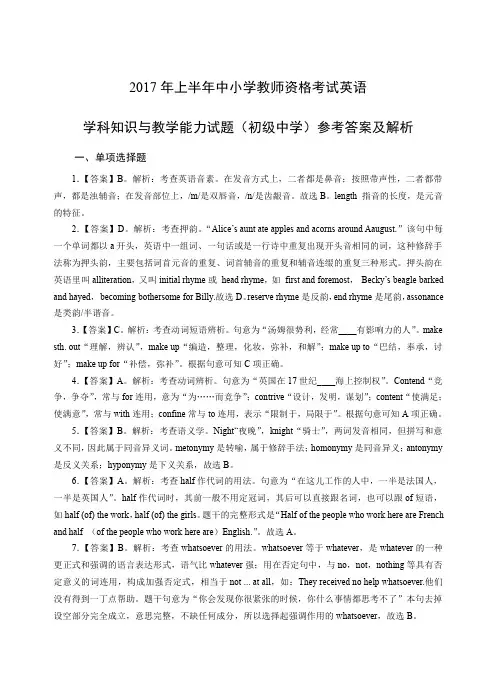
2017年上半年中小学教师资格考试英语学科知识与教学能力试题(初级中学)参考答案及解析一、单项选择题1.【答案】B。
解析:考查英语音素。
在发音方式上,二者都是鼻音;按照带声性,二者都带声,都是浊辅音;在发音部位上,/m/是双唇音,/n/是齿龈音。
故选B。
length指音的长度,是元音的特征。
2.【答案】D。
解析:考查押韵。
“Alice’s aunt ate apples and acorns around Aaugust.”该句中每一个单词都以a开头,英语中一组词、一句话或是一行诗中重复出现开头音相同的词,这种修辞手法称为押头韵,主要包括词首元音的重复、词首辅音的重复和辅音连缀的重复三种形式。
押头韵在英语里叫alliteration,又叫initial rhyme或head rhyme,如first and foremost,Becky’s beagle barked and hayed,becoming bothersome for Billy.故选D。
reserve rhyme是反韵,end rhyme是尾韵,assonance 是类韵/半谐音。
3.【答案】C。
解析:考查动词短语辨析。
句意为“汤姆很势利,经常____有影响力的人”。
make sth.out“理解,辨认”,make up“编造,整理,化妆,弥补,和解”;make up to“巴结,奉承,讨好”;make up for“补偿,弥补”。
根据句意可知C项正确。
4.【答案】A。
解析:考查动词辨析。
句意为“英国在17世纪____海上控制权”。
Contend“竞争,争夺”,常与for连用,意为“为……而竞争”;contrive“设计,发明,谋划”;content“使满足;使满意”,常与with连用;confine常与to连用,表示“限制于,局限于”。
根据句意可知A项正确。
5.【答案】B。
解析:考查语义学。
Night“夜晚”,knight“骑士”,两词发音相同,但拼写和意义不同,因此属于同音异义词。
2017上半年初中英语教师资格证面试真题(精选)第四批初中英语《Cartoon》一、考题回顾二、考题解析《Cartoon》主要教学过程及板书设计教学过程Step 1 Lead-in1. Greeting to Ss.2. Show a cartoon Steamboat Willie to Ss, and then ask them some questions:----Do you like to watch cartoon?----What is your favorite cartoon?----Why do you like it?Step 2 Pre-readingAccording to the pictures on ppt. and the movie they saw in Lead-in part, Ss need to predict which one is the main idea of this passage.The options present on PPT:----Mickey Mouse, a famous symbol in American culture.----Some cartoons with Mickey Mouse.----Disney theme parks around the world.----What people think of cartoons?Step 3 While-reading1. Fast readingAsk students to read the passage quickly and then check their prediction answers.2. Careful readingHave Ss to read this passage carefully and talk about the main characterin the cartoon. And then work with their partners to discuss the following chart:Then talk about their favorite Disney characters. T writes down their answers on the blackboard and ask Ss vote for their favorite Disney characters and write the number of vote on the board.Disney characters: Mickey Mouse, Minnie Mouse, Donald Duck, Mulan, Goofy, Snow White…Then four students a group to discuss why people love this Disney characters.Step 4 Post-readingFour students in a group, find another cartoon character just as famous as Mickey, and then to discuss why is the character popular.Step 5 Summary and Homework1. Summary: ask students to review what they’ve learnt today, and then T makes a conclusion.2. Homework: Does a role playDivide the class into several groups; each group has 5-6 students. They need to choose their favorite carton and each group member act as a role of the cartoon.板书设计答辩题目解析1.简述下,阅读教学中每次阅读的作用/目的分别是什么?【参考答案】首先,在快速阅读环节中,让学生第一遍快速阅读全文,判断自己在pre-reading部分所做的推测是否正确。
2017年上半年教师资格统考《英语学科(初中)》试题一、单选题(本大题共20小题,每小题2分,共40分在每小题列出的四个备选项中选择一个最佳答案,请用2B铅笔把答题卡上对应题目的答案字母按要求涂黑。
错选、多选或未选均无分。
)1.The main difference between/m/and/n/lies in_____.A.manner of articulationB.place of articulationC.voicingD.length2._____is the main rhyming pattern in the sentence"Alice's aunt ate apples and acorns around August."A.Reverse rhymeB.End rhymeC.AssonanceD.Alliteration3.Tom is snobbish,always_____the influential people.A.making out forB.making upC.making up toD.making up for4.Britin_____for control of the sea in the17th Century.A.contendedB.contrivedC.contentedD.confined5.Which of the following best describes the relation between night and knight?A.metonymyB.homonymyC.antonymyD.hyponymy6.Of the people who work here,_____are French and_____English.A.half…halfB.the half…the halfC.a half…a halfD.a half…the half7.You'll find yourself thinking about nothing_____whofen you are very nervous.A.whereverB.whatsoeverC.wheneverD.however8.Mr.Johnson has a habit of asking question_____.A.and then not listen to the answersB.but then not listen for the answersC.and then not listening to the answersD.and then doesn't listen to the answers9.On hearing the utterance"It's hot here",the listener open the door.It is a (n)_____.A.locutionary actB.illocutionary actC.direct speech actD.perlocutionary act10.What rhetoric device is used in the sentence"many hands make light work"?A.SynecdocheB.SimileC.MetaphorD.Oxymoron11.When the teacher attempts to elicit more information from the students by saying "And…?","Good.Anything else?",etc,he/she is playing the role of a_____.A.prompterB.participantC.managerD.consultant12.For more advanced learners,group work may be more appropriate than pair work for tasks that are_____.A.linguistically simpleB.structurally controlledC.cognitively challengingD.thematically non-demanding13.When you focus on"utterance function"and"expected response"by using examples like"Here you are","Thanks",you are probably teaching language at the_____.A.lexical levelB.sentence levelC.grammatical levelD.discourse level14.Which of the following tasks fails to encourage active language use?A.Reciting a textB.Bargaining in a shopC.Writing an application letterD.Reading to get message15.A teacher may encourage students to_____when they come across new words in fast reading.A.take notesB.ask for helpC.guess meaning from contextD.look up the words in a dictionary16.Which of the following statements about task design is incorrect?A.Activities must have clear and attainable objectivesB.Activities should be confined to the classroom contextC.Activities must be relevant to student's life experiencesD.Activities should help develop students'language ability.17.If someone says"I know the word",he should not only understand its meaning but also be able to pronounce,spell,and_____it.A.explainB.recognizeC.memorizee18.Teachers could encourage students to use_____to gather and organize their ideas for writing.A.elicitingB.mind mappingC.explainingD.brainstorming19.When students are asked to go to the local museum,libraries,etc.to find out information about endangered animals and work out a plan for an exhibition,they are doing a(n)_____.A.surveyB.experimentC.projectD.presentation20.Which of the following tasks fails to develop students'skill of recognizing discourse patterns?A.Analyzing the student of difficult sentencesB.Checking the logic of the author's argumentsC.Getting the scrambled sentences into a paragraphD.Marking out common openers to stories and jokes.请阅读Passage1,完成21~25小题。
20XX上半年教师资格证面试真题及解析:初中英语(第四批)初中英语《Cartoon》一、考题回顾二、考题解析《Cartoo n》主要教学过程及板书设计教学过程Step 1 Lead-i n1. Greeti ng to Ss.2. Show a cartoon Steamboat Willie to Ss, and then ask them some question矚: 慫润厲钐瘗睞枥庑赖。
矚慫润厲钐瘗睞枥庑赖賃。
----Do you like to watch carto on?----What is your favorite carto on?----Why do you like it?Step 2 Pre-read ingAccord ing to the pictures on ppt. and the movie they saw in Lead-i n part, Ss n eed to predict which one is the mai n idea of this passage聞創沟燴鐺險爱氇谴净。
聞創沟燴鐺險爱氇谴净祸。
The opti ons prese nt on PPT:----Mickey Mouse, a famous symbol in America n culture 残骛楼諍锩瀨濟溆塹籟。
残骛楼諍锩瀨濟溆塹籟婭。
----Some carto ons with Mickey Mouse.----Disney theme parks around the world.----What people thi nk of carto ons?Step 3 While-readi ng1. Fast readi ngAsk stude nts to read the passage quickly and the n check their predicti on an swers 酽锕极額閉镇桧猪訣锥。
20XX上半年教师资格证面试真题及解析:初中英语(第一批)初中英语《What are you going to be when you grow up?〉、考题回顾二、考题解析《What are you going to be when you grow up?〉主要教学过程及板书设计矚慫润厲钐瘗睞枥庑赖。
矚慫润厲钐瘗睞枥庑赖賃。
教学过程Stepl Warmin g-up:Listen to a song, “Be what you wanna be ft e r. lAitieharg, I will ask aquestion: what can you hear from the song? Yes, many professions, such as lawyer, doctor and so on. And the n I will ask stude nts, “ what do they want to be whe n they grow up ” and ask some students to answer the question. An(ethl will tell students we can also say “what are you going to be when you grow up ” and lead to today class聞創沟燴鐺險爱氇谴净。
聞創沟燴鐺險爱氇谴净祸。
Step2 Pre-liste ning:I will show some pictures on the PPT, the first picture is about reporter and the sec ond picture is about the article. I will write dow n the two words on the blackboard and the n I will ask the stude nts to read after me 残骛楼諍锩瀨濟溆塹籟。
2016年上半年中小学教师资格考试真题试卷《英语学科知识与教学能力》(初级中学)(满分150分)一、单项选择题(本大题共30小题,每小题2分,共60分)1. Walnut trees____environment stresses such as drought by producing significant amounts of a substance similar to aspirin.A. turn toB. confirm toC. contribute toD. respond to2. John felt great____about his upcoming trip to Sidney;indeed, he could hardly contain his enthusiasm.A. unrestB. uncertaintyC. anxietyD. excitement3. The professor’s classroom manner was quite____, never revealing the warmth and playfulness she showed in private.A. livelyB. amiableC. formalD. cheerful4. Again as____in this experiment, he did n’t lose heart.A. he failedB. did he failC. he did failD. had he failed5. Taiwan lies____the east of Fujian and is larger than____island in China.A. to;anyB. in;anyC. to;any otherD. in;any other6. Johnson is a man of great experience, ____much can be learned.A. for whomB. for whichC. from thatD. from whom7. Which of the following shows the correct sentence stress in normal casesA. His ?brother is my ?best friend.B. They ?help one ?another in their work.C. They have ?been in the ?countryside recently.D. She ?thought herself ?better ?than ?anyone else.8. The phrase“____”exemplifies the incomplete plosion at the junction of words.A. good morningB. black shirtC. delicious cherryD. beautiful jacket9. The synonymous pair “____” differ in degree of formality.A. pass away and pop offB. accuse and chargeC. prison and jailD. tap and faucet10. When using the imperative “Turn it off” to give an order, the speaker highlights the____of the utterance.A. locutionary actB. illocutionary actC. perlocutionary actD. indirect speech act11. Fluent and appropriate language use requires knowledge of____and this suggests that we should teach lexical chunks rather than single words.A. connotationB. denotationC. morphologyD. collocation12.“Underlining all the past form verbs in the dialogue”is a typical exercise focusing on ____.A. useB. formC. meaningD. function13. Which of the following activities may be more appropriate to help students practice a new structure immediately after presentation in classA. Role play.B. Group discussion.C. Pattern drill.D. Written homework.14. When teaching students how to give appropriate responses to a congratulation or an apology, the teacher is probably teaching at ____.A. lexical levelB. sentence levelC. grammatical levelD. discourse level15. Which of the following activities can help develop the skill of listening for gistA. Listen and find out where Jim lives.B. Listen and decide on the best title for the passage.C. Listen and underline the words the speaker stresses.D. Listen to pairs of words and tell if they are the same.16. When an EFL teacher asks his students“How do you know that the author liked the place since he did not tell us explicitly”, he/she is helping students to reach____comprehension.A. literalB. evaluativeC. inferentialD. appreciative17. Which of the following types of questions are mostly used for checking literal comprehension of the textA. Display questions.B. Rhetorical questions.C. Evaluation questions.D. Referential questions.18. Which of the following is a typical feature of informal writingA. A well-organized structure is preferred.B. Short and incomplete sentences are common.C. Technical terms and definitions are required.D. A wide range of vocabulary and structural patterns are used.19. Peer-editing during class is an important step of the____approach to teaching.A. genre-basedB. content-basedC. process-orientedD. product-oriented20. Portfolios, daily reports and speech delivering are typical means of ____.A. norm-referenced testB. criterion-referenced testC. summative assessmentD. formative assessment阅读Passage 1,完成第21~25小题。
Passage 1Sante Fe, New Mexico multimillionaire Forrest Fenn has always loved a good adventure. As a small child before eight, he and his brother, Skippy spent summer vacations making exploration in Yellowstone National Park.As a teen, Fenn idolized the decorated World War Ⅱfighter pilot, called Robin Olds and latter emulated his hero during the Vietnam War as an Air fighter pilot to go to New Mexico and settled there as an arts and antiques dealer, hunting down valuablepaintings, rugs, war memorabilia, and other antique to sell.In 1998, Fenn was diagnosed with terminal kidney cancer. As he had always been doing, he conceived a grand adventure that he assumed would be his last one. “I wanted to create some excitement, some hope, before I died,”says Fenn, 82, adding that he also wanted to “get kids out of the game room and off the couch.” With those ideas in his mind, he started to devise a treasure hunt.Little by little, Fenn began stocking a small bronze chest with gold coins, prehistoric bracelets and other valuable things. When his cancer went into remission in 1993, he decided he would carry out his plan anyway.In 2010, Fenn topped off the chest with jewels and valuable stones and hid it somewhere deep in the Rocky Mountains, north of Sante Fe. Later that year, he wrote a poem for his self-published memoir, The Thrill of the Chase. It contained nine clues about the treasure box’s whereabouts. One stanza reads like this:Begin it where warm waters halt/And take it in the canyon down/Not far, but too far to walk/Put in below the home of Brown.A few months later, a story about the treasure appeared in a magazine. Since then, Fenn has received thousands of e-mails from treasure hunters. Some request more clues to the box. But mostly “people thanked me for bringing their family together,”he says with a self-comforting smile on his face.In April, Fenn told a crowd at an Albuquerque bookstore that two groups of treasure hunters had gotten within 500 feet of the chest. “They walked right by it,” he said.Fenn is confident that the treasure will be unearthed eventually and says it will take the right combination of cunning and perseverance. “It will be discovered by someone who has read the clues carefully and successfully. But nobody is going to happen upon it,” he predicts.He hopes that whoever finds the loot will relish the riches and the adventure of finding them.21. Who was a fighter pilot during the Vietnam War according to the passageA. Skippy.B. Robin Olds.C. Sante Fe.D. Forrest Fenn.22. Which of the following is closest in meaning to the underlined phrase “topped off”in Paragraph FiveA. Filled.B. Covered.C. Fixed.D. Decorated.23. Why did Fenn design a treasure hunt after he was diagnosed with cancerA. He enjoyed adventures and could n’t help doing it.B. He wanted to help himself and game- and telly-addicted kids.C. He wanted to get the kids out of the game room to play with him.D. He thought it could bring him hope, excitement and a longer life.24. What did Fenn enjoy most from treasure hunters according to the passageA. Their requests about more clues.B. Their tremendous interest in the game.C. Their news about getting their family closer.D. Their numerous emails about their perseverance.25. What does the underlined word “it” in the last but two paragraph refer toA. The riches.B. The treasure.C. The adventure.D. The treasure discovery.阅读Passage 2, 完成第26~30小题。